Early Childhood Education and Care: Ethical Dilemmas Case Study
VerifiedAdded on 2023/06/08
|8
|1500
|438
Case Study
AI Summary
This assignment presents a series of case studies related to early childhood education and care, addressing ethical and legal obligations within that context. The scenarios cover topics such as child safety, confidentiality, conflict resolution, social media conduct, professional ethics, dignity of risk, child behavior management, and identifying potential child abuse. Each case requires a detailed response outlining appropriate actions, considering relevant legislation like the Children and Young Persons Act, Fair Work Amendment Act, and national laws regarding defamation, as well as ethical guidelines from the Early Childhood Australia Code of Ethics and the Early Years Learning Framework. The responses emphasize the importance of creating a safe, respectful, and supportive environment for children while adhering to legal and ethical standards, highlighting the educator's duty of care and the need for reporting concerns to relevant authorities. The document also includes a reference list.
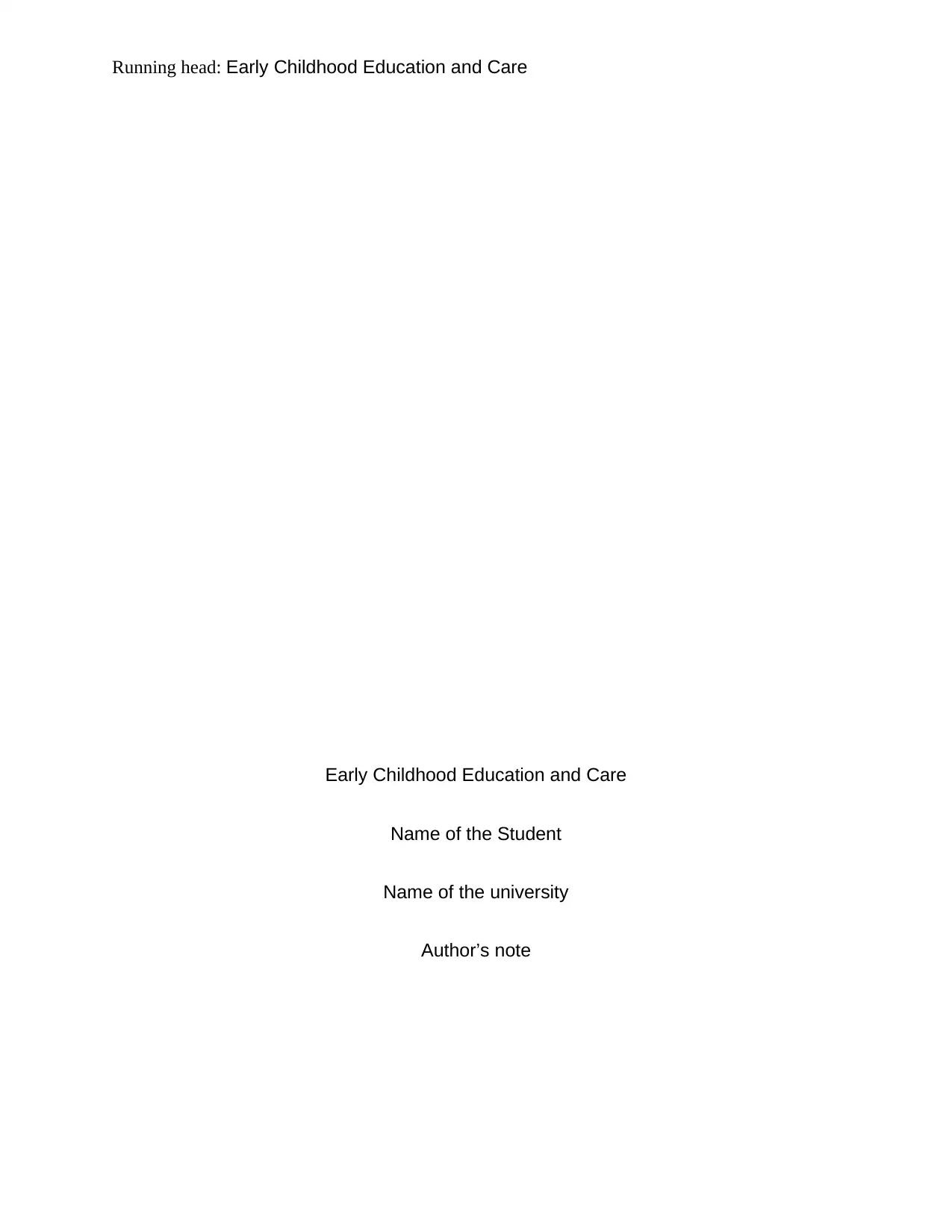
Running head: Early Childhood Education and Care
Early Childhood Education and Care
Name of the Student
Name of the university
Author’s note
Early Childhood Education and Care
Name of the Student
Name of the university
Author’s note
Paraphrase This Document
Need a fresh take? Get an instant paraphrase of this document with our AI Paraphraser
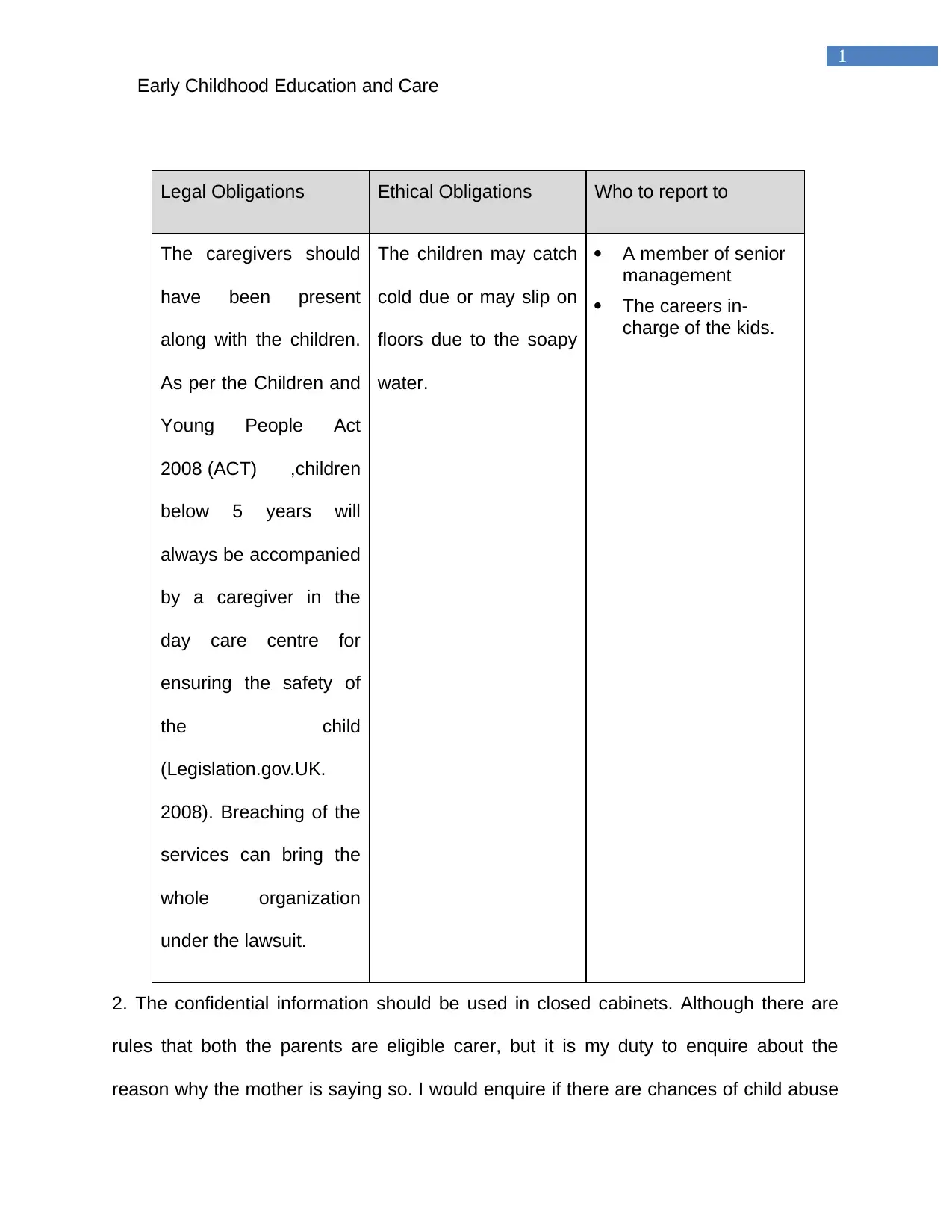
1
Early Childhood Education and Care
Legal Obligations Ethical Obligations Who to report to
The caregivers should
have been present
along with the children.
As per the Children and
Young People Act
2008 (ACT) ,children
below 5 years will
always be accompanied
by a caregiver in the
day care centre for
ensuring the safety of
the child
(Legislation.gov.UK.
2008). Breaching of the
services can bring the
whole organization
under the lawsuit.
The children may catch
cold due or may slip on
floors due to the soapy
water.
A member of senior
management
The careers in-
charge of the kids.
2. The confidential information should be used in closed cabinets. Although there are
rules that both the parents are eligible carer, but it is my duty to enquire about the
reason why the mother is saying so. I would enquire if there are chances of child abuse
Early Childhood Education and Care
Legal Obligations Ethical Obligations Who to report to
The caregivers should
have been present
along with the children.
As per the Children and
Young People Act
2008 (ACT) ,children
below 5 years will
always be accompanied
by a caregiver in the
day care centre for
ensuring the safety of
the child
(Legislation.gov.UK.
2008). Breaching of the
services can bring the
whole organization
under the lawsuit.
The children may catch
cold due or may slip on
floors due to the soapy
water.
A member of senior
management
The careers in-
charge of the kids.
2. The confidential information should be used in closed cabinets. Although there are
rules that both the parents are eligible carer, but it is my duty to enquire about the
reason why the mother is saying so. I would enquire if there are chances of child abuse
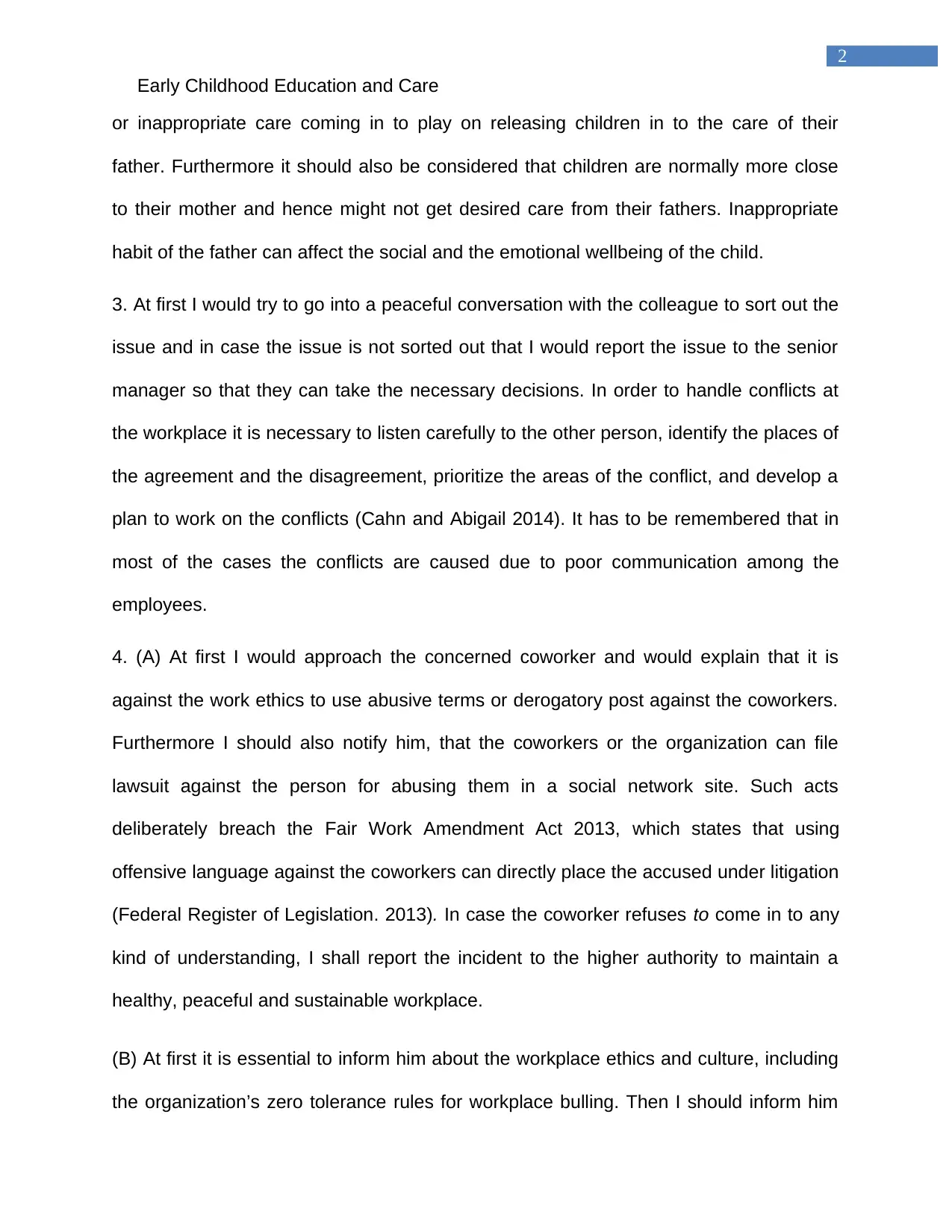
2
Early Childhood Education and Care
or inappropriate care coming in to play on releasing children in to the care of their
father. Furthermore it should also be considered that children are normally more close
to their mother and hence might not get desired care from their fathers. Inappropriate
habit of the father can affect the social and the emotional wellbeing of the child.
3. At first I would try to go into a peaceful conversation with the colleague to sort out the
issue and in case the issue is not sorted out that I would report the issue to the senior
manager so that they can take the necessary decisions. In order to handle conflicts at
the workplace it is necessary to listen carefully to the other person, identify the places of
the agreement and the disagreement, prioritize the areas of the conflict, and develop a
plan to work on the conflicts (Cahn and Abigail 2014). It has to be remembered that in
most of the cases the conflicts are caused due to poor communication among the
employees.
4. (A) At first I would approach the concerned coworker and would explain that it is
against the work ethics to use abusive terms or derogatory post against the coworkers.
Furthermore I should also notify him, that the coworkers or the organization can file
lawsuit against the person for abusing them in a social network site. Such acts
deliberately breach the Fair Work Amendment Act 2013, which states that using
offensive language against the coworkers can directly place the accused under litigation
(Federal Register of Legislation. 2013). In case the coworker refuses to come in to any
kind of understanding, I shall report the incident to the higher authority to maintain a
healthy, peaceful and sustainable workplace.
(B) At first it is essential to inform him about the workplace ethics and culture, including
the organization’s zero tolerance rules for workplace bulling. Then I should inform him
Early Childhood Education and Care
or inappropriate care coming in to play on releasing children in to the care of their
father. Furthermore it should also be considered that children are normally more close
to their mother and hence might not get desired care from their fathers. Inappropriate
habit of the father can affect the social and the emotional wellbeing of the child.
3. At first I would try to go into a peaceful conversation with the colleague to sort out the
issue and in case the issue is not sorted out that I would report the issue to the senior
manager so that they can take the necessary decisions. In order to handle conflicts at
the workplace it is necessary to listen carefully to the other person, identify the places of
the agreement and the disagreement, prioritize the areas of the conflict, and develop a
plan to work on the conflicts (Cahn and Abigail 2014). It has to be remembered that in
most of the cases the conflicts are caused due to poor communication among the
employees.
4. (A) At first I would approach the concerned coworker and would explain that it is
against the work ethics to use abusive terms or derogatory post against the coworkers.
Furthermore I should also notify him, that the coworkers or the organization can file
lawsuit against the person for abusing them in a social network site. Such acts
deliberately breach the Fair Work Amendment Act 2013, which states that using
offensive language against the coworkers can directly place the accused under litigation
(Federal Register of Legislation. 2013). In case the coworker refuses to come in to any
kind of understanding, I shall report the incident to the higher authority to maintain a
healthy, peaceful and sustainable workplace.
(B) At first it is essential to inform him about the workplace ethics and culture, including
the organization’s zero tolerance rules for workplace bulling. Then I should inform him
⊘ This is a preview!⊘
Do you want full access?
Subscribe today to unlock all pages.

Trusted by 1+ million students worldwide
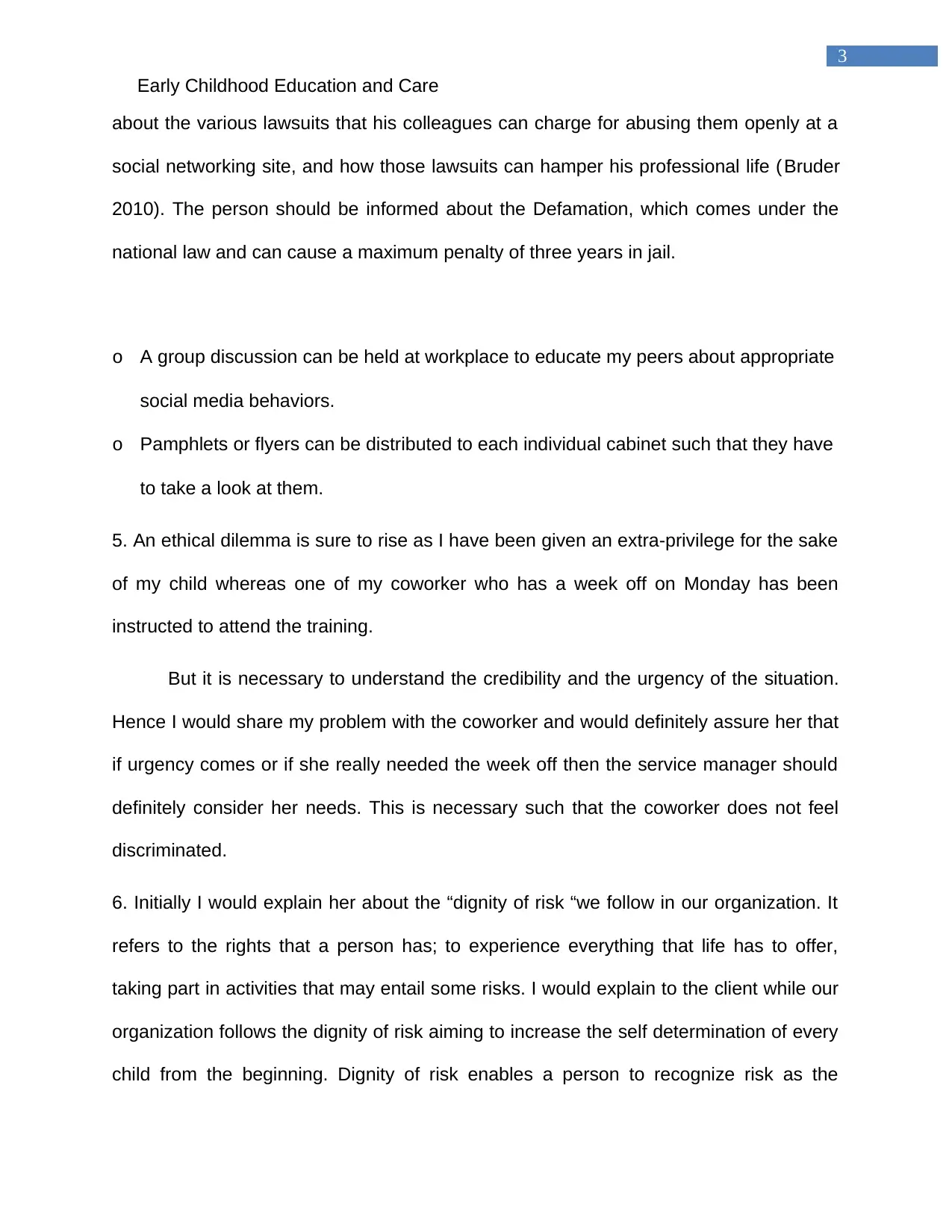
3
Early Childhood Education and Care
about the various lawsuits that his colleagues can charge for abusing them openly at a
social networking site, and how those lawsuits can hamper his professional life ( Bruder
2010). The person should be informed about the Defamation, which comes under the
national law and can cause a maximum penalty of three years in jail.
o A group discussion can be held at workplace to educate my peers about appropriate
social media behaviors.
o Pamphlets or flyers can be distributed to each individual cabinet such that they have
to take a look at them.
5. An ethical dilemma is sure to rise as I have been given an extra-privilege for the sake
of my child whereas one of my coworker who has a week off on Monday has been
instructed to attend the training.
But it is necessary to understand the credibility and the urgency of the situation.
Hence I would share my problem with the coworker and would definitely assure her that
if urgency comes or if she really needed the week off then the service manager should
definitely consider her needs. This is necessary such that the coworker does not feel
discriminated.
6. Initially I would explain her about the “dignity of risk “we follow in our organization. It
refers to the rights that a person has; to experience everything that life has to offer,
taking part in activities that may entail some risks. I would explain to the client while our
organization follows the dignity of risk aiming to increase the self determination of every
child from the beginning. Dignity of risk enables a person to recognize risk as the
Early Childhood Education and Care
about the various lawsuits that his colleagues can charge for abusing them openly at a
social networking site, and how those lawsuits can hamper his professional life ( Bruder
2010). The person should be informed about the Defamation, which comes under the
national law and can cause a maximum penalty of three years in jail.
o A group discussion can be held at workplace to educate my peers about appropriate
social media behaviors.
o Pamphlets or flyers can be distributed to each individual cabinet such that they have
to take a look at them.
5. An ethical dilemma is sure to rise as I have been given an extra-privilege for the sake
of my child whereas one of my coworker who has a week off on Monday has been
instructed to attend the training.
But it is necessary to understand the credibility and the urgency of the situation.
Hence I would share my problem with the coworker and would definitely assure her that
if urgency comes or if she really needed the week off then the service manager should
definitely consider her needs. This is necessary such that the coworker does not feel
discriminated.
6. Initially I would explain her about the “dignity of risk “we follow in our organization. It
refers to the rights that a person has; to experience everything that life has to offer,
taking part in activities that may entail some risks. I would explain to the client while our
organization follows the dignity of risk aiming to increase the self determination of every
child from the beginning. Dignity of risk enables a person to recognize risk as the
Paraphrase This Document
Need a fresh take? Get an instant paraphrase of this document with our AI Paraphraser
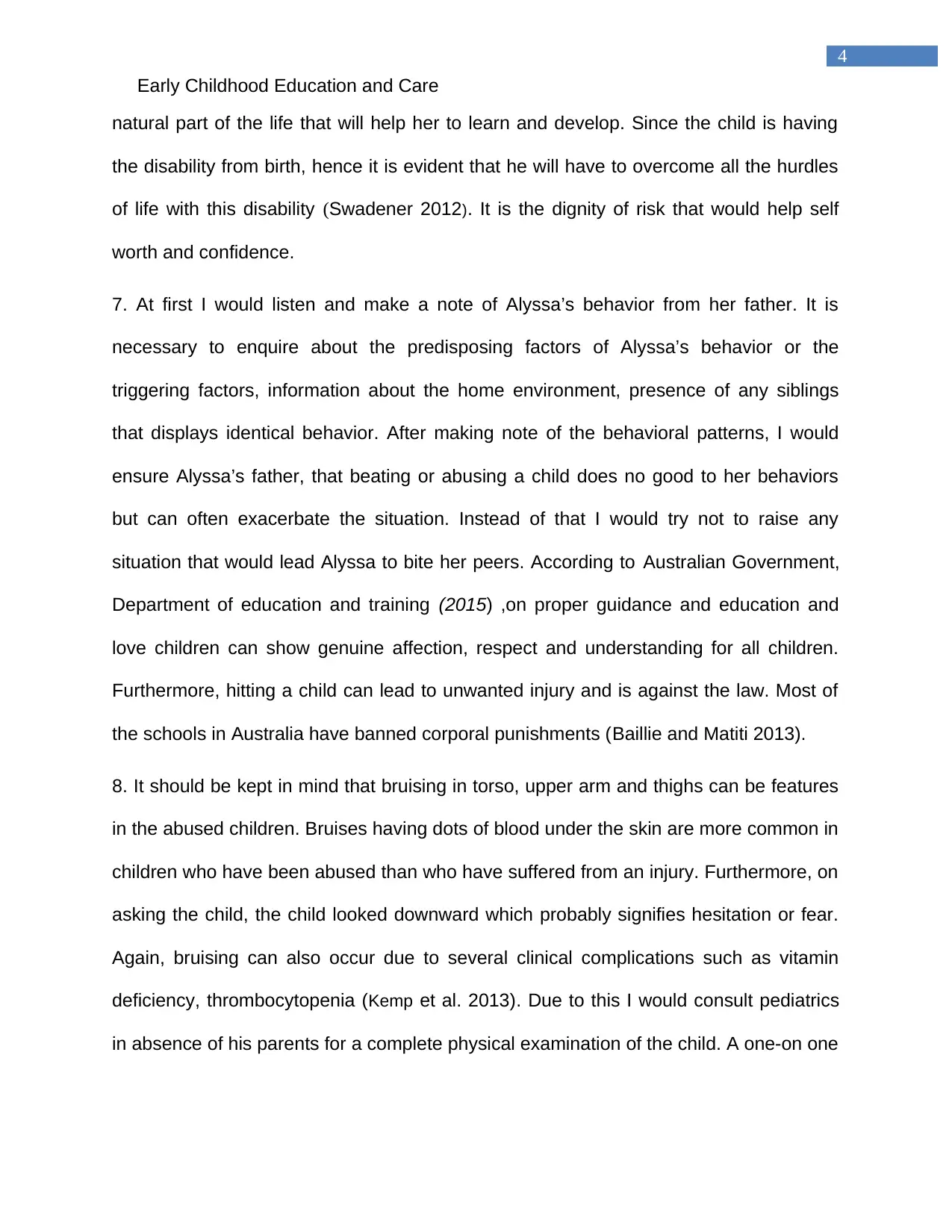
4
Early Childhood Education and Care
natural part of the life that will help her to learn and develop. Since the child is having
the disability from birth, hence it is evident that he will have to overcome all the hurdles
of life with this disability (Swadener 2012). It is the dignity of risk that would help self
worth and confidence.
7. At first I would listen and make a note of Alyssa’s behavior from her father. It is
necessary to enquire about the predisposing factors of Alyssa’s behavior or the
triggering factors, information about the home environment, presence of any siblings
that displays identical behavior. After making note of the behavioral patterns, I would
ensure Alyssa’s father, that beating or abusing a child does no good to her behaviors
but can often exacerbate the situation. Instead of that I would try not to raise any
situation that would lead Alyssa to bite her peers. According to Australian Government,
Department of education and training (2015) ,on proper guidance and education and
love children can show genuine affection, respect and understanding for all children.
Furthermore, hitting a child can lead to unwanted injury and is against the law. Most of
the schools in Australia have banned corporal punishments (Baillie and Matiti 2013).
8. It should be kept in mind that bruising in torso, upper arm and thighs can be features
in the abused children. Bruises having dots of blood under the skin are more common in
children who have been abused than who have suffered from an injury. Furthermore, on
asking the child, the child looked downward which probably signifies hesitation or fear.
Again, bruising can also occur due to several clinical complications such as vitamin
deficiency, thrombocytopenia (Kemp et al. 2013). Due to this I would consult pediatrics
in absence of his parents for a complete physical examination of the child. A one-on one
Early Childhood Education and Care
natural part of the life that will help her to learn and develop. Since the child is having
the disability from birth, hence it is evident that he will have to overcome all the hurdles
of life with this disability (Swadener 2012). It is the dignity of risk that would help self
worth and confidence.
7. At first I would listen and make a note of Alyssa’s behavior from her father. It is
necessary to enquire about the predisposing factors of Alyssa’s behavior or the
triggering factors, information about the home environment, presence of any siblings
that displays identical behavior. After making note of the behavioral patterns, I would
ensure Alyssa’s father, that beating or abusing a child does no good to her behaviors
but can often exacerbate the situation. Instead of that I would try not to raise any
situation that would lead Alyssa to bite her peers. According to Australian Government,
Department of education and training (2015) ,on proper guidance and education and
love children can show genuine affection, respect and understanding for all children.
Furthermore, hitting a child can lead to unwanted injury and is against the law. Most of
the schools in Australia have banned corporal punishments (Baillie and Matiti 2013).
8. It should be kept in mind that bruising in torso, upper arm and thighs can be features
in the abused children. Bruises having dots of blood under the skin are more common in
children who have been abused than who have suffered from an injury. Furthermore, on
asking the child, the child looked downward which probably signifies hesitation or fear.
Again, bruising can also occur due to several clinical complications such as vitamin
deficiency, thrombocytopenia (Kemp et al. 2013). Due to this I would consult pediatrics
in absence of his parents for a complete physical examination of the child. A one-on one
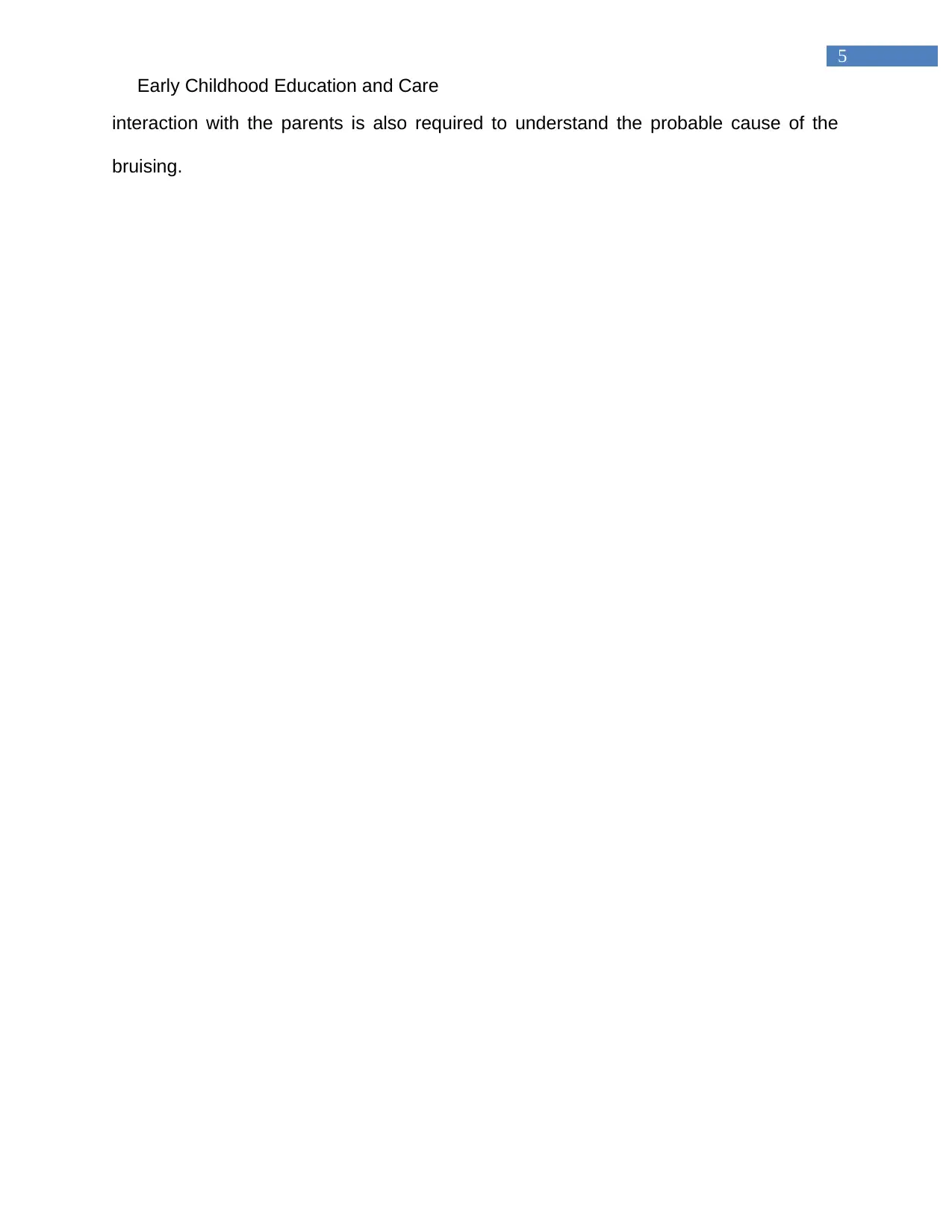
5
Early Childhood Education and Care
interaction with the parents is also required to understand the probable cause of the
bruising.
Early Childhood Education and Care
interaction with the parents is also required to understand the probable cause of the
bruising.
⊘ This is a preview!⊘
Do you want full access?
Subscribe today to unlock all pages.

Trusted by 1+ million students worldwide
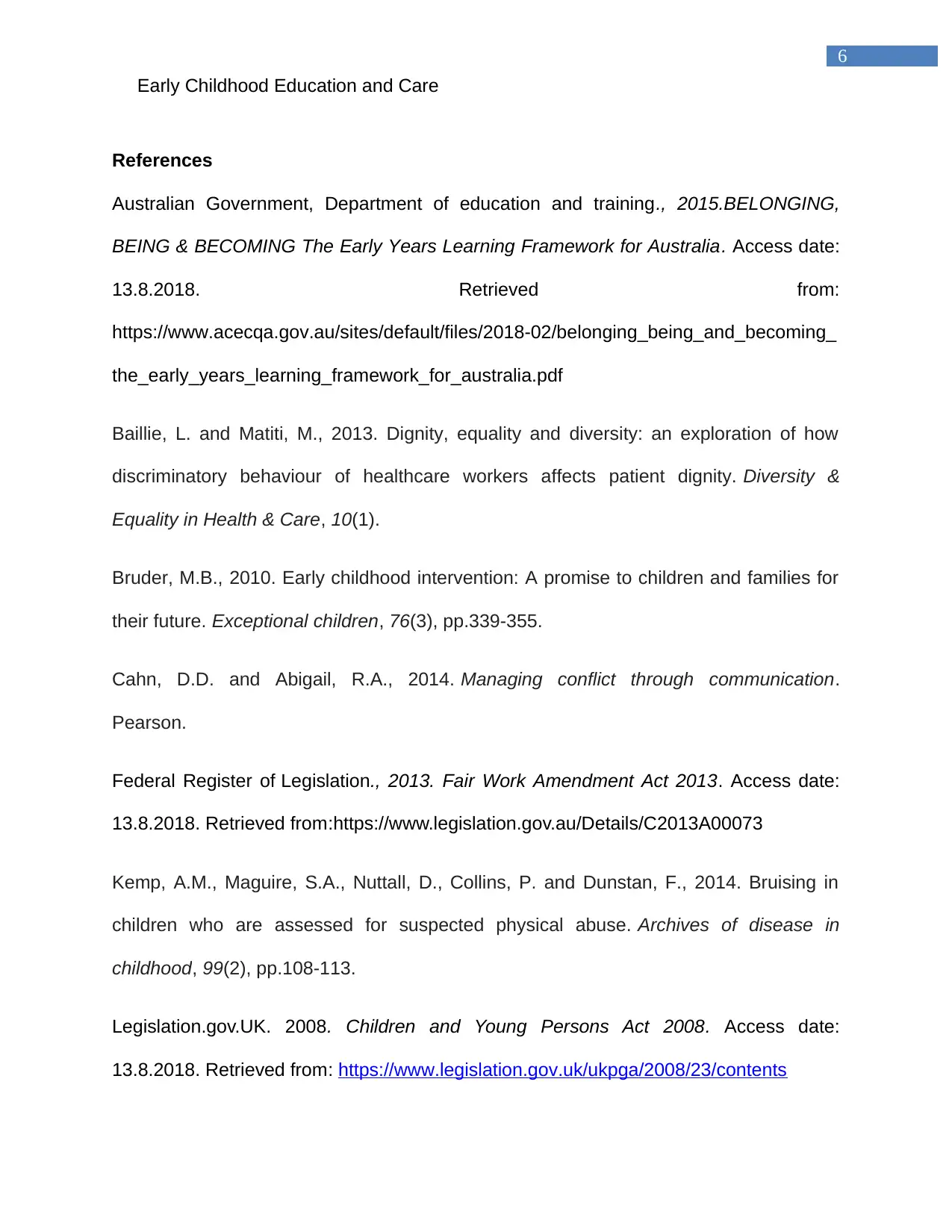
6
Early Childhood Education and Care
References
Australian Government, Department of education and training., 2015.BELONGING,
BEING & BECOMING The Early Years Learning Framework for Australia. Access date:
13.8.2018. Retrieved from:
https://www.acecqa.gov.au/sites/default/files/2018-02/belonging_being_and_becoming_
the_early_years_learning_framework_for_australia.pdf
Baillie, L. and Matiti, M., 2013. Dignity, equality and diversity: an exploration of how
discriminatory behaviour of healthcare workers affects patient dignity. Diversity &
Equality in Health & Care, 10(1).
Bruder, M.B., 2010. Early childhood intervention: A promise to children and families for
their future. Exceptional children, 76(3), pp.339-355.
Cahn, D.D. and Abigail, R.A., 2014. Managing conflict through communication.
Pearson.
Federal Register of Legislation., 2013. Fair Work Amendment Act 2013. Access date:
13.8.2018. Retrieved from:https://www.legislation.gov.au/Details/C2013A00073
Kemp, A.M., Maguire, S.A., Nuttall, D., Collins, P. and Dunstan, F., 2014. Bruising in
children who are assessed for suspected physical abuse. Archives of disease in
childhood, 99(2), pp.108-113.
Legislation.gov.UK. 2008. Children and Young Persons Act 2008. Access date:
13.8.2018. Retrieved from: https://www.legislation.gov.uk/ukpga/2008/23/contents
Early Childhood Education and Care
References
Australian Government, Department of education and training., 2015.BELONGING,
BEING & BECOMING The Early Years Learning Framework for Australia. Access date:
13.8.2018. Retrieved from:
https://www.acecqa.gov.au/sites/default/files/2018-02/belonging_being_and_becoming_
the_early_years_learning_framework_for_australia.pdf
Baillie, L. and Matiti, M., 2013. Dignity, equality and diversity: an exploration of how
discriminatory behaviour of healthcare workers affects patient dignity. Diversity &
Equality in Health & Care, 10(1).
Bruder, M.B., 2010. Early childhood intervention: A promise to children and families for
their future. Exceptional children, 76(3), pp.339-355.
Cahn, D.D. and Abigail, R.A., 2014. Managing conflict through communication.
Pearson.
Federal Register of Legislation., 2013. Fair Work Amendment Act 2013. Access date:
13.8.2018. Retrieved from:https://www.legislation.gov.au/Details/C2013A00073
Kemp, A.M., Maguire, S.A., Nuttall, D., Collins, P. and Dunstan, F., 2014. Bruising in
children who are assessed for suspected physical abuse. Archives of disease in
childhood, 99(2), pp.108-113.
Legislation.gov.UK. 2008. Children and Young Persons Act 2008. Access date:
13.8.2018. Retrieved from: https://www.legislation.gov.uk/ukpga/2008/23/contents
Paraphrase This Document
Need a fresh take? Get an instant paraphrase of this document with our AI Paraphraser
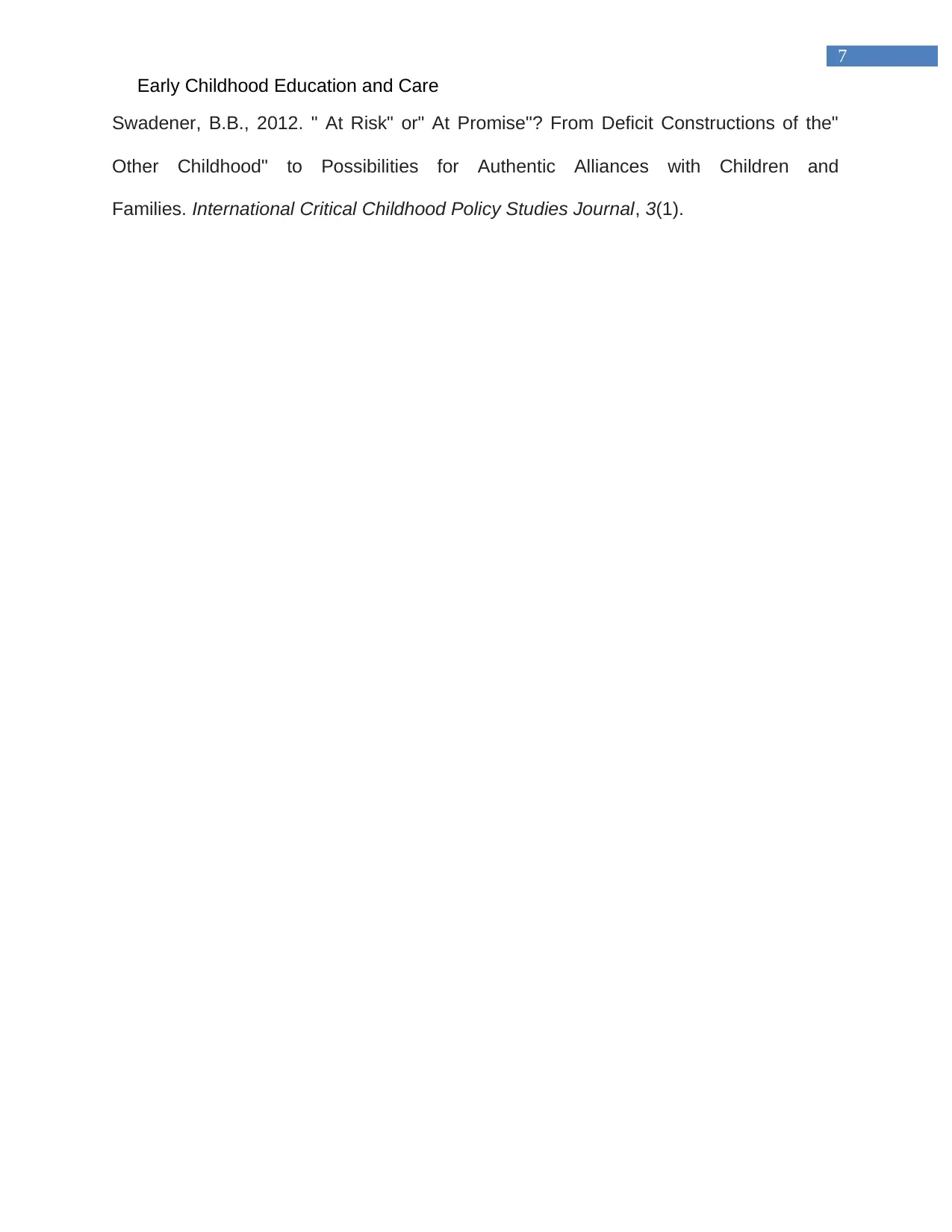
7
Early Childhood Education and Care
Swadener, B.B., 2012. " At Risk" or" At Promise"? From Deficit Constructions of the"
Other Childhood" to Possibilities for Authentic Alliances with Children and
Families. International Critical Childhood Policy Studies Journal, 3(1).
Early Childhood Education and Care
Swadener, B.B., 2012. " At Risk" or" At Promise"? From Deficit Constructions of the"
Other Childhood" to Possibilities for Authentic Alliances with Children and
Families. International Critical Childhood Policy Studies Journal, 3(1).
1 out of 8
Related Documents
Your All-in-One AI-Powered Toolkit for Academic Success.
+13062052269
info@desklib.com
Available 24*7 on WhatsApp / Email
![[object Object]](/_next/static/media/star-bottom.7253800d.svg)
Unlock your academic potential
Copyright © 2020–2025 A2Z Services. All Rights Reserved. Developed and managed by ZUCOL.




